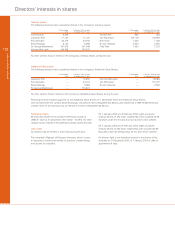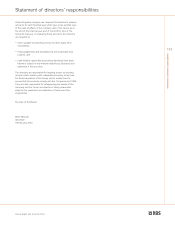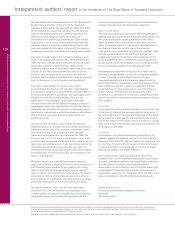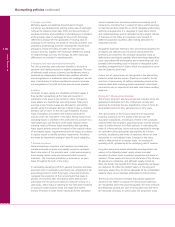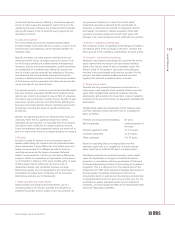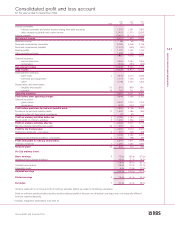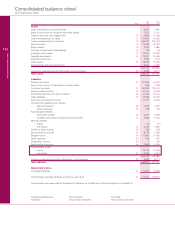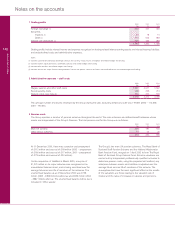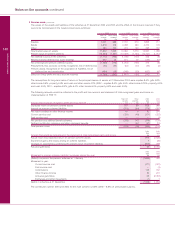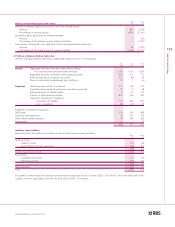RBS 2003 Annual Report Download - page 141
Download and view the complete annual report
Please find page 141 of the 2003 RBS annual report below. You can navigate through the pages in the report by either clicking on the pages listed below, or by using the keyword search tool below to find specific information within the annual report.
Annual Report and Accounts 2003
139
Accounting policies
are financed by the reinsurer offering a nil premium payment
period. In these cases, the acquisition costs incurred on the
underlying insurance contracts are compared with the benefit
arising with respect to the nil premium paying period on the
reinsurance contract.
9 Loans and advances
The Group makes provisions for bad and doubtful debts,
through charges to the profit and loss account, so as to record
impaired loans and advances at their expected ultimate net
realisable value.
Specific provisions are made against individual loans and
advances that the Group no longer expects to recover in full.
For the Group’s portfolios of smaller balance homogeneous
advances, such as credit card receivables, specific provisions
are established on a portfolio basis taking into account the
level of arrears, security and past loss experience. For loans
and advances that are individually assessed, the specific
provision is determined from a review of the financial condition
of the borrower and any guarantor and takes into account the
nature and value of any security held.
The general provision is made to cover bad and doubtful debts
that have not been separately identified at the balance sheet
date but are known to be present in any portfolio of advances.
The level of general provision is determined in the light of past
experience, current economic and other factors affecting the
business environment and the Group’s monitoring and control
procedures, including the scope of specific provisioning
procedures.
Specific and general provisions are deducted from loans and
advances. When there is significant doubt that interest
receivable can be collected, it is excluded from the profit and
loss account and credited to an interest suspense account.
Loans and advances and suspended interest are written off in
part or in whole when there is no realistic prospect of recovery.
10 Taxation
Provision is made for taxation at current enacted rates on
taxable profits taking into account relief for overseas taxation
where appropriate. Timing differences arise where gains and
losses are accounted for in different periods for financial
reporting purposes and for taxation purposes. Deferred
taxation is accounted for in full for all such timing differences,
except in relation to revaluations of fixed assets where there is
no commitment to dispose of the asset, taxable gains on sales
of fixed assets that are rolled over into the tax cost of
replacement assets, and unremitted overseas earnings.
Deferred tax assets are only recognised to the extent that it is
considered more likely than not that they will be recovered.
Deferred tax amounts are not discounted.
11 Debt securities and equity shares
Debt securities and equity shares intended for use on a
continuing basis in the Group’s activities are classified as
investment securities and are stated at cost less provision for
any permanent diminution in value. The cost of dated
investment securities is adjusted for the amortisation of
premiums or discounts over periods to redemption and the
amortisation is included in interest receivable. Other debt
securities and equity shares are carried at fair value, with
changes in fair value recognised in the profit and loss account.
12 Shares in subsidiary undertakings
The company’s shares in subsidiary undertakings are stated in
the balance sheet of the company at directors’ valuation that
takes account of the subsidiary undertakings’ net asset values.
13 Interests in associated undertakings
Interests in associated undertakings are accounted for by the
equity method and are stated in the consolidated balance
sheet at the Group’s share of their net tangible assets. The
Group’s share of the results of associated undertakings is
included in the consolidated profit and loss account. For this
purpose, the latest available audited accounts are used
together with available unaudited interim accounts.
14 Tangible fixed assets
Freehold and long leasehold properties are revalued on a
rolling basis, each property being revalued at least every five
years. Other tangible fixed assets are stated at cost less
depreciation and provisions for impairment. Costs of adapting
premises for the use of the Group are separately identified and
depreciated.
Tangible fixed assets are depreciated to their residual value
over their estimated useful economic lives on a straight-line
basis, as follows:
Freehold and long leasehold buildings 50 years
Short leaseholds unexpired period of
the lease
Property adaptation costs 10 to 15 years
Computer equipment up to 5 years
Other equipment 4 to 15 years
Assets on operating leases are depreciated over their
estimated useful lives on a straight-line or reverse-annuity
basis. Land has an unlimited life and is not depreciated.
Investment properties are revalued annually to open market
value. No depreciation is charged on freehold investment
properties, in accordance with the requirements of Statement
of Standard Accounting Practice 19 ‘Accounting for investment
properties’. This is a departure from the requirements of the
Companies Act 1985 which requires all tangible fixed assets to
be depreciated. Investment properties are held not for
consumption but for investment and the directors consider that
to depreciate them would not give a true and fair view. It is not
practicable to assess estimated useful lives for investment
properties, and accordingly the effect of not depreciating them
cannot be reasonably quantified.





